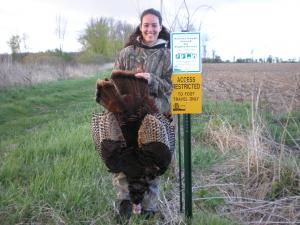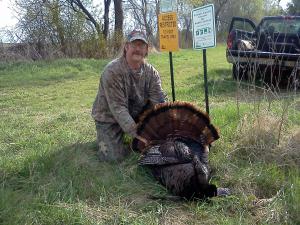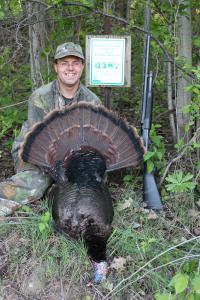So, You’d Like to Hunt Wild Turkey?
Spring hunting in Wisconsin is all about turkeys!
MILWAUKEE, WISCONSIN, USA, May 7, 2019 /EINPresswire.com/ -- Whether you grew up in a family of hunters or not, hunting your own food can be a satisfying experience. For boys and girls, it can help them understand the food cycle, learn about gun safety, and teach them a life-long sport. Adults may enjoy the sport, spending time in nature, or passing this tradition along to family and friends. Spring hunting in Wisconsin is all about turkeys!Wild turkeys are a conservation success story. Habitat destruction and overhunting in the 18th and 19th centuries led to a decline in the wild turkey population. In the 1930’s, an estimated 250,000 birds remained in the U.S. Since that time, directed efforts in wildlife management have brought the number of wild turkeys back up to an estimated 6.2 million birds . Wild turkeys were reintroduced in Wisconsin in 1976. Most states do limit the number of birds you may harvest. In Wisconsin, you may take one bird (male/bearded) in the spring and one bird (either sex) in the fall hunt with the appropriate harvest authorization.
Hunting Turkeys
Turkeys can be a challenge to hunt, so it is worth a little time to improve your odds of harvesting one. If you are new to turkey hunting, you may find the Wisconsin Turkey Hunters Guide helpful (https://dnr.wi.gov/topic/hunt/documents/turkguide.pdf). The National Wild Turkey Federation recommends adjusting and testing your shotgun pattern to improve your odds of dropping a bird in one shot. Instructions can be found here: http://www.nwtf.org/hunt/article/evaluate-turkey-gun-pattern.
What You Need
To harvest a turkey in Wisconsin, you will need a spring turkey license, stamp, and harvest authorization for the spring season. While more than half of the harvest authorizations are awarded through a preference-based drawing, bonus harvest authorizations are available for purchase beginning in March and ending when the authorization limit has been reached or the season ends. To check on the number of remaining harvest authorizations, visit https://dnr.wi.gov/permits/springturkey.html.
The Wisconsin Department of Natural Resources offers hunter training through the Learn to Hunt program and Mentored Hunting program. For those born on or after January 1, 1973, you are required to take a hunter safety class before going out or participate in mentored hunting. There is also a Wild Turkey Hunt for People with Disabilities who wish to participate.
Make sure you have the right gear for the weather and blaze orange is strongly encouraged near blinds or when moving from one location to another! The DNR recommends using non-toxic (not lead based) ammunition as lead may have significant negative effects on humans.
When is Turkey Season?
Wisconsin has both spring and fall turkey seasons. Dates for 2019 are shown here:
2019 Spring Turkey Dates
Youth turkey hunt
April 13-14
Spring turkey hunting period A
April 17 – 23
Spring turkey hunting period B
April 24 - 30
Spring turkey hunting period C
May 1 - 7
Spring turkey hunting period D
May 8 – 14
Spring turkey hunting period E
May 15 - 21
Spring turkey hunting period F
May 22 - 28
2019 Fall Turkey Dates
September 14 - January 5, 2020
Zones 1 - 5
September 14 - November 22
Zones 6 - 7
Where Can You Hunt Wild Turkey?
Wisconsin DNR has more than 1.6 million acres of public access lands and an additional 34,000 acres of voluntary public access (VPA) lands open to hunting. Another 2,500 acres are specifically designated for spring turkey hunting under the Turkey Hunter Access Program (THAP)., If family or friends own land, they may invite you to hunt turkey there. You can find a map of public and VPA lands at https://dnr.wi.gov/topic/Lands/PAL/.
Success!
If your hunt is successful, by law you must register your bird (using the harvest authorization number). Go online to https://dnr.wi.gov/topic/Hunt/ereg.html or call the Harvest Registration Hotline at 1-844-426-3734 so the DNR can track and manage the number of birds harvested.
Should you wish to donate your turkey, please take it to an approved processor and follow the instructions on the WI DNR website at https://dnr.wi.gov/topic/hunt/turkeyDonation.html.
Why are there set dates and limits on birds taken?
Wisconsin has some of the highest hunter densities in the nation. The Wisconsin Department of Natural Resources works hard to manage both the lands and wildlife populations. Limiting the number of birds harvested helps keep the turkey population healthy and prevents overhunting. The six, one-week periods allow for a safer and more enjoyable hunt by spreading out the hunting pressure over time and space. The dates selected for turkey harvesting take into account turkey mating season to ensure hunters do not unintentionally impact reproduction.
Not Ready to Hunt Yet?
The fall turkey season begins September 14, 2019. There are two end dates, depending on the turkey management zone. There is not a preference-based drawing for the fall hunt. One harvest authorization is included with the purchase of a fall turkey or conservation patron license. Hunters specify their preferred zone at the time they purchase the license. Bonus authorizations may be available in the fall for certain zones. For those interested in the spring 2020 turkey season, the harvest authorization application deadline is December 10, 2019. Applications may be submitted online, at a DNR Service Center, or at a license sales location. Learn more at https://dnr.wi.gov/topic/hunt/apply.html.
Share the Land: The Turkey Hunter Access Program
Private landowners with more than 40 acres that have adequate wild turkey habitat may earn money by opening their lands during spring turkey season (March 1 – May 29). For landowners in this program the only activity allowed on the property is spring turkey hunting (versus landowners enrolled in the Voluntary Public Access program). Lease rates are $5/acre. Learn more by visiting https://dnr.wi.gov/topic/lands/thap/.
Cody Strong, VPA-HIP & THAP Coordinator
Wisconsin Department of Natural Resources
+1 608-800-1343
email us here
Legal Disclaimer:
EIN Presswire provides this news content "as is" without warranty of any kind. We do not accept any responsibility or liability for the accuracy, content, images, videos, licenses, completeness, legality, or reliability of the information contained in this article. If you have any complaints or copyright issues related to this article, kindly contact the author above.



